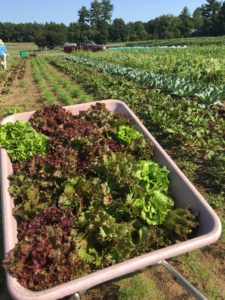Thanksgiving is often a lavish feast for most people.
Pilgrim-inspired staples, such as cranberry jelly, mashed potatoes, stuffing and of course the star-of-the-show – a turkey – adorn an autumn-themed table surrounded by loved ones as conversations of gratitude and football fill the air.
But what happens to those who don’t have a home or who struggle to find their next meal? Sure, giving campaigns raise awareness for local hunger issues, leading canned food drives and increased volunteerism in soup kitchens and food pantries. But, the majority of the homeless population goes hungry on this holiday.
Hunger in America is not only a lack of access to food, it’s a lack of access to nutrition. Many chronic diseases like diabetes, obesity and heart disease are linked to eating foods that are high in calories and low in nutrition. These foods also tend to cost less. Many food pantries and shelters cannot offer fresh produce due to transportation, financial and storage limitations. Instead, they rely on canned and boxed foods as staples which are typically higher in fat, sugar and sodium.

Fresh food is grown and harvested for the residents at Pine Street Inn.
The number of people experiencing homelessness in Massachusetts continues to rise. A 2016 City of Boston Homeless Census conducted by the Emergency Shelter Commission revealed nearly 3,500 individuals were recorded homeless in Boston just this past winter. Approximately half of those individuals were living in shelters. Others were found living on the streets or participating in programs at medical facilities or in transitional housing. Despite numbers rising, proper nutrition for this population is often neglected.
Earlier this fall, as reported by The Boston Globe, WHDH-TV’s Urban Update, WGBH’s Friday News Quiz, WCVB-TV’s 5 for Good and Spare Change News, Teak’s client Food For Free, a Cambridge-based food rescue agency, partnered with Pine Street Inn, the largest resource for homeless men and women in New England, to bring fresh healthy food directly from the field to the shelter. Weekly, Food For Free volunteers picked between 200 and 400 pounds of fresh produce, including bundles of chard, lettuce, scallions, carrots, beets, and tomatoes, from the nonprofit’s own Field of Greens. Food For Free drivers made a same day delivery to Pine Street Inn where shelter staff members worked to sort through the food to prepare the next day. The following day, Pine Street Inn’s Executive Chef Frank van Overbeeke rose to the challenge to create close to 2,000 meals daily with the produce presented to him. Meals included roasted beet salad with a vinaigrette dressing and sautéed swiss chard.
Before this initiative, which ran from July through October (the end of growing season) donations typically came in the form of canned or pre-packaged goods. This was the first time Pine Street Inn received fresh farm produce donations. For many shelter guests, this was the first time they were exposed to the concept of farm to table. Not only did guests get access to healthy vegetables, the fresh produce was also used as an educational tool for those who participate in Pine Street’s culinary training program, iCater Boston, as they transition from shelter to the workforce.
According to the Natural Resources Defense Council, more than 40 percent of all food produced in the United States goes to waste. Furthermore, if not rescued, the same fresh and wholesome fruits and vegetables that are bringing much needed nutrition to those in need would end up in landfills where they would produce methane gas – a leading pollutant and cause of climate change – as they decompose. Food waste is the largest source of solid waste in landfills.
Individuals and families need to shop smarter and smaller, cook creatively and reuse leftovers. Local markets, large institutions and super or smaller markets should donate their surplus food.
As you begin to place your turkey orders and reserve shares at your local farmer’s market, be mindful of what is going to be on your plate this holiday season and how you can help to feed hungry families in your own backyard.


